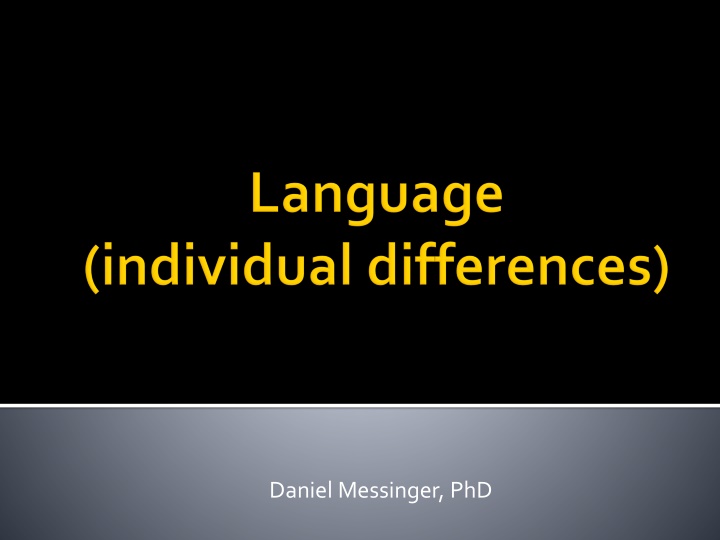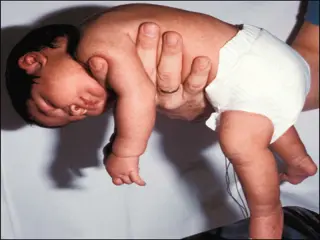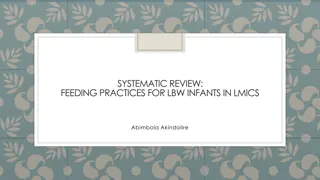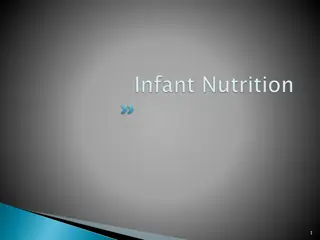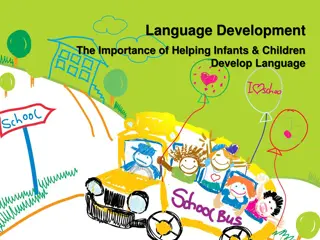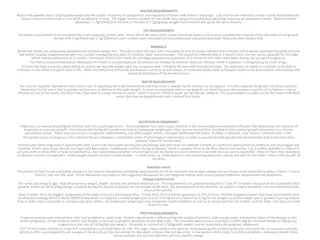Language Development in Infants: Insights from Dr. Daniel Messinger, PhD
Dr. Daniel Messinger, PhD, discusses the early language development of infants, highlighting their ability to perceive phonetic differences and the influence of linguistic environments. The development process involves permanent changes, including speech categorization by 8 months congruent with the native language. Various studies explore the interactions between parents and infants, shedding light on mechanisms of language development and vocalizations in infants.
Download Presentation

Please find below an Image/Link to download the presentation.
The content on the website is provided AS IS for your information and personal use only. It may not be sold, licensed, or shared on other websites without obtaining consent from the author.If you encounter any issues during the download, it is possible that the publisher has removed the file from their server.
You are allowed to download the files provided on this website for personal or commercial use, subject to the condition that they are used lawfully. All files are the property of their respective owners.
The content on the website is provided AS IS for your information and personal use only. It may not be sold, licensed, or shared on other websites without obtaining consent from the author.
E N D
Presentation Transcript
At birth, infants are capable of discriminating all phonetically relevant differences in the world s languages They perceptually partition the acoustic space underlying phonetic distinctions in a universal way. By 6 months of age, infants raised in different linguistic environments show an effect of language experience. Their representations are becoming language specific 100 90 80 70 60 6-8 Months 8-10 Months 10-12 Months 50 40 30 20 10 2 0 Dentral vs. retroflex "t"
Development involves relatively permanent change, but not always improvement in all things. 8
By 8 months, infants categorize speech into phonemes congruent with native language Recent studies of mother-infant interactions found little mimicry by prelinguistic infants MOST matching is from parents imitating infants Alternate mechanism of language development: caregivers consistently respond to babbling and cause changes in patterns of vocalizations (contingent reinforcement)
Even though these vocalizations occur in a specific developmental order
1. Do children exhibit word class bias in their first 10 words? 2. How variable are these words across languages?
Distribution of Childrens Home Location 970 children learning: American English Mandarin Chinese Cantonese Chinese Children were sampled from the US, Hong Kong, and Beijing Children were screened for a number of medical exclusion criteria Parents of the children were native speakers of their particular language United States 265 369 Beijing 336 Hong Kong
6 of the top 20 words appeared in all three languages Almost all categories had strong similarities in words that appeared Children first learned nouns that were manipulable objects that they frequently
Children across cultures consistently produced people terms Prevalence of object and animal words varied across cultures Most words children produced fell into people and sounds/ sound effect categories Fewest words in adjectives and closed class categories
Children across cultures consistently produced people terms Prevalence of object and animal words varied across cultures Most words were people and sounds/ sound effects Fewest words in adjectives and closed class categories
Children from Beijing Children from the US Children from Hong Kong
There are perceptual differences between solid objects and nonsolid substances that lead to an early appreciation of their distinction explored whether naming of nonsolids would improve if they were tested in typical/familiar context of highchair during mealtime Children tested in the highchair demonstrated better understanding of how nonsolids are named, demonstrating a developmental cascade between context, exploration, and word learning
child was given the exemplar object and the two test items to explore experimenter asked children to find their own exemplar, either by name (warm up), with novel names (test), or with no name children classified via parental reports on messiness and whether they used a highchair or booster at home coded the final choice (shape versus material) Figure 1 Example stimuli sets used in experiment. Left panel shows a whole exemplar set; right panel shows a pieces exemplar set.
There are differences in language development across SES Environment plays a role in language development Mothers are primary source of language experience Is the effect of environment global or is there evidence for environmental specificity?
Explain the relationship between SES and language development through environmental specificity Identify underlying mechanism of this relationship Hypotheses Differences in children s SES-related language-learning experiences can explain SES differences in vocabulary development Maternal speech mediates the relationship between SES and vocabulary development
Participants (N=63) Children ages 16-31 months 33 High-SES families College educated Employed in professional or managerial positions 30 Mid-SES families High School education Employed in unskilled, semiskilled, or service position Moms not employed outside the home more than 15 hr/week
Measures Maternal Speech - linguistic and social properties Child Vocabulary - # of word types in 90-utterance speech sample Mediation Model SES Child Vocabulary SES Maternal Speech Maternal Speech Child Vocabulary Strength of relationship between SES and Child Vocabulary reduced Correlations and Multiple Regression Alert
SES maternal speech Childrearing beliefs Time availability Maternal speech language growth Provides data for child s word-learning mechanisms Longer utterance -> more variance in word types (richer vocabulary) Longer utterance -> more info about meaning Longer utterance -> richer syntax
Relationship between SES and language development influenced by language experiences Evidence for environmental specificity Enriching language experience can increase vocabulary development for lower SES children
Meaningful differences in the everyday experiences of young American children. Hart & Risley (1995). Baltimore, MD: Brookes Publishing Co 48
Parenting = Language diversity + feedback tone + symbolic emphasis + guidance style + responsiveness Predicts between and within SES groups 50
To intervene with vocabulary growth rate increase the experiences available to the children Limited success ultimately the growth rates increased only temporarily. Could easily increase the size of the children s vocabularies, could not accelerate the developmental trajectory. Removing barriers and offering opportunities and incentives is not enough to overcome the past, the transmission across generations of a culture of poverty. 52
90% of children with sensory neural hearing losses born to hearing parents Important Factors: Maternal sensitivity SES Age of cochlear implantation Duration of auditory deprivation Parental linguistic input Quantitative (Word types, Mean length of utterance) Qualitative (Facilitative language techniques [FLTs])
93 children 2 years of age and younger at pre- implantation Baseline: 2-4 weeks prior to cochlear implantation surgery, with return visit 4-6 weeks later for implantation activation Assessments at 6 months (not included in data), 12 months, 24 months, and 36 months 6 month demographics, Reynell Developmental Language scales, videotaped interactions (one structured, one unstructured)
